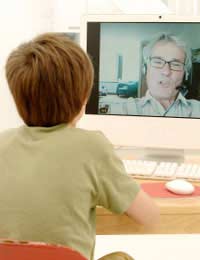Signing Using Telecommunications

With the advent of ever-increasingly complicated technology, the ways in which deaf people can communicate have multiplied. However, sign language still remains at the heart of the best sorts of communications for deaf people as it is a universal language and one for which there is no need for any expensive or complex equipment, Having said this, it would be wrong to think that telecommunications has not made an impact on sign language – it has. The very fact you are reading this on the internet is testament to the fact people can find out about, learn and research sign language in a multitude of ways which were not available 25 years or so ago.
Early Sign Language Telecommunications
The first ways in which telecommunications really affected the way in which people used sign language was the advent of videophones – as far back as the 1960s, although their use was obviously then restricted to a specialist audience. But the first videophone, named a picturephone, captured the public’s imagination when shown to them for the first time as it was clear that two deaf people in far away places were able to have a conversation using sign language. The stage was then set for ever-more complicated telecommunications methods to aid and assist sign language users.Video Relay
The introduction of services such as Skype in very recent times now means that deaf people with a computer and an internet connection anywhere in the world can communicate with each other. But this is, relatively speaking, a very recent invention. Until now, the most common way that the early idea of the videophone has made a difference to sign language users is through video relay. The video relay service works much along the lines of having a translator with a videophone on hand to be able to translate your signs to the person you are talking to. The translator can watch the signs the sign language user makes and speak them to the other person, wherever they may be.There is also a service known as video remote interpreting where the people having the conversation are in the same place. The interpreter is in a third place and the signs are relayed to the interpreter remotely. The interpreter then tells the other person what is being said and then translates their response into sign language as well.
Of course, all of this technology is well and good, but it does cost money to install all of the equipment. Some people may feel it is worthwhile and decide to invest – but as stated above, Skype is making much of the old technology obsolete. In fact, the internet has revolutionised much of the way people communicate full stop – not just deaf people. The one thing it has not yet managed to do is render interpreters useless. There may be ways of translating the written word on a computer, but as yet, no one has come up with an entirely foolproof way of translating signs to spoken and back again with no human help.


Re: The Listening Bus
Hi, We would like to book the listening bus for our school community. What is your availability for the summer term 2025? What are the costs? We…
Re: Sign Supported English
Ex Mary hare school. Love sign supported English as Aspie. More useful Less emotional As words Not emotion More helpful to deaf Aspies
Re: The Listening Bus
Hi, I am the inclusion leader and SENCo of a school with a specialist resource provision for deaf pupils within a mainstream school. Staff say…
Re: The British Sign Language Broadcasting Trust
I’m not effected in any way or suffer from any communication issues personally. I was curious as to why…
Re: Sign Supported English
I want a series of videos to learn SIGN SUPPORTED ENGLISH FOR BEGINNERS. Can you please help?
Re: Makaton
Hello We are a small pre-school and we are trying to teach all our children Makaton to help all of them communicate regardless of their own…
Re: Sign Supported English
Can anyone help me ? I am trying to find an SSE class or lessons in Kent and have had no luck. Failing that, are there any publications I…
Re: Hands on Signing
Hi I have a blind child and he has a moderate hearing loss. I wonder if you can help me to teach him sign language and I need to learn as well.…
Re: Sign Supported English
Does anyone know of any programmes or resources for using SSE with older people whose hearing has deteriorated in later life?
Re: Makaton
what is makaton??????????????????????????